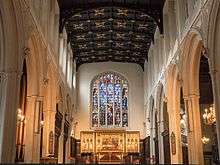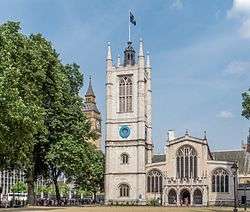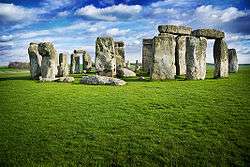St Margaret's, Westminster
| St Margaret's, Westminster Abbey | |
|---|---|
|
St Margaret's Church, Westminster Abbey. The Central Tower of the Palace of Westminster is in the background. | |
| Location | City of Westminster, London, UK |
| Coordinates | 51°30′00″N 00°07′37″W / 51.50000°N 0.12694°WCoordinates: 51°30′00″N 00°07′37″W / 51.50000°N 0.12694°W |
| Founded | 12th Century |
| Rebuilt | 1486 to 1523 |
| Official name: Palace of Westminster, Westminster Abbey and Saint Margaret's Church | |
| Type | Cultural |
| Criteria | i, ii, iv |
| Designated | 1987 (11th session) |
| Reference no. | 426 |
| Country | United Kingdom |
| Region | Europe and North America |
 Location of St. Margaret, Westminster Abbey in central London | |
The Church of St Margaret, Westminster Abbey, is situated in the grounds of Westminster Abbey on Parliament Square, and is the Anglican parish church[1] of the House of Commons of the United Kingdom in London. It is dedicated to Margaret of Antioch.[2]
History and description
Founded in the twelfth century by Benedictine monks, so that local people who lived in the area around the Abbey[3] could worship separately at their own simpler parish church, and historically part of the hundred of Ossulstone in the county of Middlesex,[4] St Margaret's was rebuilt from 1486 to 1523. It became the parish church of the Palace of Westminster in 1614, when the Puritans of the seventeenth century, unhappy with the highly liturgical Abbey, chose to hold Parliamentary services in the more "suitable" St Margaret's:[5] a practice that has continued since that time.
The Rector of St Margaret's is a canon of Westminster Abbey.
The north-west tower was rebuilt by John James from 1734 to 1738; at the same time, the whole structure was encased in Portland stone. Both the eastern and the western porch were added later by J. L. Pearson. The church's interior was greatly restored and altered to its current appearance by Sir George Gilbert Scott in 1877,[6] although many of the Tudor features were retained.
Commemorative windows and notable burials
Notable features include the east window of 1509 of Flemish stained glass, created to commemorate the betrothal of Catherine of Aragon to Henry VIII.[7] Other windows commemorate William Caxton, Britain's first printer, who was buried at the church in 1491, Sir Walter Raleigh, executed in Old Palace Yard[8] and then also buried in the church in 1618, the poet John Milton, a parishioner of the church, and Admiral Robert Blake. The collector Henry Constantine Jennings is also buried there.[9]
Other notable burials include those of John Sutton, 3rd Baron Dudley, "Lord Quondam", 18 September 1553; his wife Lady Cicely Grey, 28 April 1554; William Murray, 2nd Earl of Tullibardine, 30 July 1627; Edward Grimeston, 14 December 1640; and Wenceslas Hollar, died 25 March 1677. Also Bishop Nicholas Clagett.
Following the Restoration of the Monarchy, in 1661 the Parliamentarians who had been buried in Westminster Abbey (Admiral Robert Blake, Denis Bond, Nicholas Boscawen,[10] Mary Bradshaw, Sir William Constable, Admiral Richard Deane, Isaac Dorislaus, Anne Fleetwood, Thomas Hesilrige, Humphrey Mackworth, Stephen Marshall, Thomas May, John Meldrum, Admiral Edward Popham, John Pym, Humphrey Salwey, William Strong, William Stroud and William Twiss) were disinterred from the Abbey and reburied in an unmarked pit in St Margaret's churchyard on the orders of King Charles II. A memorial to them can now be found set into the external wall to the left of the main west entrance.[11]

Weddings
The church has been a common venue for society weddings which include:
- 1 December 1655: Samuel Pepys and Elisabeth de St. Michel[12]
- 12 June 1895: William Hicks and Grace Lynn Joynson
- 12 September 1908: Winston Churchill and Clementine Hozier[13]
- 21 April 1920: Harold Macmillan, and Lady Dorothy Cavendish[14]
- 18 July 1922: Lord Louis Mountbatten, and Edwina Ashley
Other weddings include that of extended members of the British Royal Family:
- 8 October 1993: David Armstrong-Jones, Viscount Linley, and the Honourable Serena Stanhope
Others notable weddings include members of the Bright Young People.[15]
The ensemble of St Margaret's, the Palace of Westminster and Westminster Abbey is a World Heritage Site. Members of Parliament and staff members of the House of Lords and House of Commons are permitted to marry in the church.
Other notable events
During the First World War, Edward Lyttelton, headmaster of Eton, gave a sermon at the church on the theme of "Loving your enemies". He spoke of his opinion that any post-war treaty with Germany should be a just one and not a vindictive one. He had to leave the church after the service by a back door, while a number of demonstrators sang "Rule Britannia" in protest at his attitude.[16]
Choirs
The treble choristers for St Margaret's are supplied by Westminster Under School.[17] The church also hosted the first performance by the UK Parliament Choir under Simon Over in 2000.
Organ
An organ was installed in 1806 by John Avery. The current organ is largely built by J. W. Walker & Sons Ltd. A specification of the organ can be found on the National Pipe Organ Register.[18]
Rectors
From 1972 to 2010, the Rector was also the Chaplain to the Speaker of the House of Commons.[19]
- William Hartley Carnegie (1912 to 1936).[20]
- David Edwards (1972 to 1978)
- John Baker (1978 to 1982)
- Trevor Beeson (1982 to 1987)
- Donald Gray (1987 to 1998)
- Robert Wright (1998 to 2010)
- Andrew Tremlett (2010 to 2016)
- Jane Sinclair (2016 onwards)[21]
Organists
Organists who have played at St Margaret's include:
- Robert Whyte 1570–1574
- John Egglestone
- John Parsons 1616–1621 (then organist of Westminster Abbey)[22]
- John Hilton 1628 – 1657(?)
- John Blow, 1695–????
- Bernard Smith, 1676–1708
- Henry Turner 1708–????
- John Illam ????–1726
- Edward Purcell, son of Henry Purcell, 1726–1740
- James Butler 1740 – 1772
- William Rock 1774 – 1802
- Michael Rock 1802 – 1809
- John Bernard Sale 1809 – 1838
- T.G. Baines around 1864 [23]
- Walter Galpin Alcock ???? – 1896
- Edwin Lemare 1897 – 1902
- Reginald Goss-Custard 1902 – 1914
- Edwin Stephenson 1914 – 1922 (formerly organist of St Philip's Cathedral, Birmingham)
- Herbert Dawson 1929 – 1965
- Martin Neary 1965 – 1972
- Richard Hickox 1972 – 1982
- Thomas Trotter
- Simon Over 1992 – 2002
- Zoe Rachel Ryan 2010 – present
Gallery
 Explanatory plaque
Explanatory plaque St Margaret's Church. To the left is the Clock Tower of the Palace of Westminster; to the right is the Abbey.
St Margaret's Church. To the left is the Clock Tower of the Palace of Westminster; to the right is the Abbey. St Margaret's, seen from the London Eye Ferris wheel
St Margaret's, seen from the London Eye Ferris wheel The nave of St Margaret's
The nave of St Margaret's
See also
References
- ↑ Westminster Abbey. "St. Margaret's, Westminster Parish details". Archived from the original on 5 March 2008. Retrieved 2008-05-03.
- ↑ Pevsner, N.; Bradley, Simon (2003). The Buildings of England: London 6 – Westminster. Uxbridge: Penguin. ISBN 0-300-09595-3.
- ↑ McManus, Mark. "St. Margaret's, Westminster". Retrieved 2008-05-03.
- ↑ Hawgood, David. "St. Margaret's, Westminster". Genuki (Genealogy UK & Ireland). Retrieved 2008-05-03.
- ↑ Wright, A.; Smith, P. (1868). Parliament Past and Present. London: Hutchinson & Co.
- ↑ Scott, George Gilbert (1995) [1879]. Stamp, Gavin, ed. Personal and Professional Recollections. [London: Sampson Low, Marston, Searle & Rivington] Stamford: Paul Watkins Publishing. ISBN 1-871615-26-7.
- ↑ Dean and Chapter, Westminster Abbey. "St Margaret's Church – The east window". St Margaret's Church. Retrieved 2010-10-21.
- ↑ Smith, Christopher. "Sir Walter Raleigh – Execution". Britannia Biographies. Retrieved 2008-05-03.
- ↑ Angelicoussis, E. (2004). "Jennings, Henry Constantine (1731–1819)". Oxford Dictionary of National Biography. Oxford: Oxford University Press. ISBN 0-19-861411-X.
- ↑ http://www.westminster-abbey.org/our-history/people/nicholas-boscawen
- ↑ Oliver Cromwell Westminster Abbey
- ↑ Pepys, Samuel (1987). Samuel Pepys, ed. The Illustrated Pepys: extracts from the Diary. Harmondsworth: Penguin. ISBN 0-14-139016-6.
- ↑ Gilbert, Martin (1991). Churchill: a life. London: Heinemann. ISBN 0-434-29183-8.
- ↑
- ↑ Taylor, D. J. (2007). Bright Young Things: the lost generation of London's Jazz Age. London: Chatto & Windus. ISBN 0-7011-7754-3. (American ed.: Farrar, Straus, and Giroux, New York, 2009)
- ↑ Alan Wilkinson, The Church of England and the First World War, London, SCM Press, 1996, p.221.
- ↑ Westminster Under School. Accessed 12 January 2013
- ↑ National Pipe Organ Register website.
- ↑ "Speaker's Chaplain". The Church in Parliament. Church of England. Retrieved 5 September 2014.
- ↑ "William and Mary Carnegie". Westminster Abbey. Retrieved 2014-08-08.
William Hartley Carnegie Canon of Westminster and Rector of St Margaret's 1913–1936. Sub Dean 1919–1936. Born 27 February 1859. Died 18 October 1936. ...
- ↑ Westminster Abbey — Sinclair appointed Rector of St Margaret's (Accessed 23 February 2016)
- ↑ Dwight's Journal of Music, p. 331
- ↑ William Charles Pearce,A Biographical Sketch of Edmund Hart Turpin, 1911
External links
| Wikimedia Commons has media related to St Margaret's, Westminster. |
- Guide to St. Margaret's
- Memorials of St. Margaret's church, Westminster, comprising the parish registers, 1539–1660, and other churchwardens' accounts, 1460–1603
- Deanery of Westminster (St Margaret)

